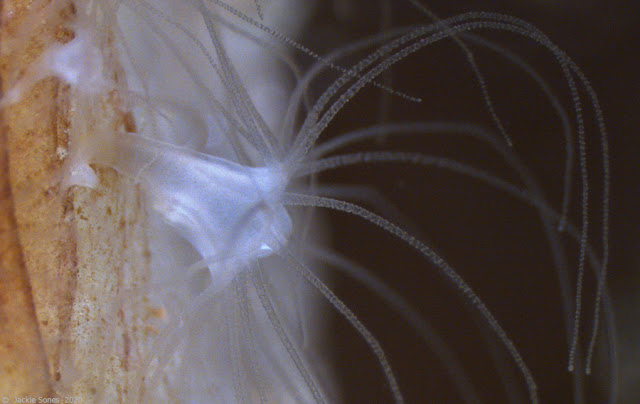Below is another photo showing a different individual, but the same type of animal:
And here are two close-ups showing the stinging tentacles, and a view of the mouth area in the middle of the ring of tentacles:
The stinging tentacles are a clue that this is a cnidarian (i.e., the group that contains jellyfish, sea anemones, corals, etc.). But which one is it?
Because this stage of the life cycle is so small (only a few millimeters long), many people haven't seen it before.
These are jellyfish polyps (also known as scyphistomae)! Eric found them growing on sea squirts at the Spud Point Marina docks.
Referring to the diagram below, the basic life cycle goes like this: free-swimming adult medusae release gametes (eggs or sperm); a fertilized egg develops into a planula larva; the planula eventually settles and undergoes metamorphosis into a benthic (bottom-dwelling) polyp; the polyp eventually undergoes fission — i.e., it buds off tiny juvenile medusae (called ephyrae) that eventually grow into the adults to complete the life cycle.
Modified from: Living Invertebrates by Vicki Pearse, John Pearse, Mildred Buchsbaum, and Ralph Buchsbaum. 1987. Blackwell Sci. Pub. and Boxwood Press.
In the image below, the polyp might be in the early stages of strobilation (note the banding pattern in the polyp):
And here's one more showing the beautiful but deadly tentacles (at least to tiny, microscopic prey):
P.S. I'm not sure which species of jellyfish this is, but perhaps someone will recognize it and let us know.






6 comments:
I love how the biology of even such a relatively simple organism is such a marvel.
Good question. Scyphopolyps are hard to differentiate due to their simple but variable morphology. Unless someone local can recognize them, you'll probably have to rear up the ephyrae or barcode them. --Allen Collins
Hi, Allen,
Thanks! We're going to see if we can raise them until they release ephyrae, so stay tuned!
:) Jackie
Good luck! How exciting!
Hey Jackie -
Curious on the approximate size of these polyps: can they be seen with a naked eye?
At Spud Marina, my favorite spot I've found so far is around the black flotation structure that the Sheriff's boat pulls up on at B dock. I haven't seen these polyps (yet!), but this is where I mentioned seeing a huge hermissenda nudi : )
Thanks!
Amber
Hi, Amber!
These polyps are quite small -- only a few millimeters tall. But if there are a lot of them, and especially when their tentacles are extended, it's possible to see them with your eyes alone. They make whatever they're growing on look like it's covered in white fuzz. We've noticed that they tend to like to be on the shaded sides of structures at the docks.
:) Jackie
Post a Comment